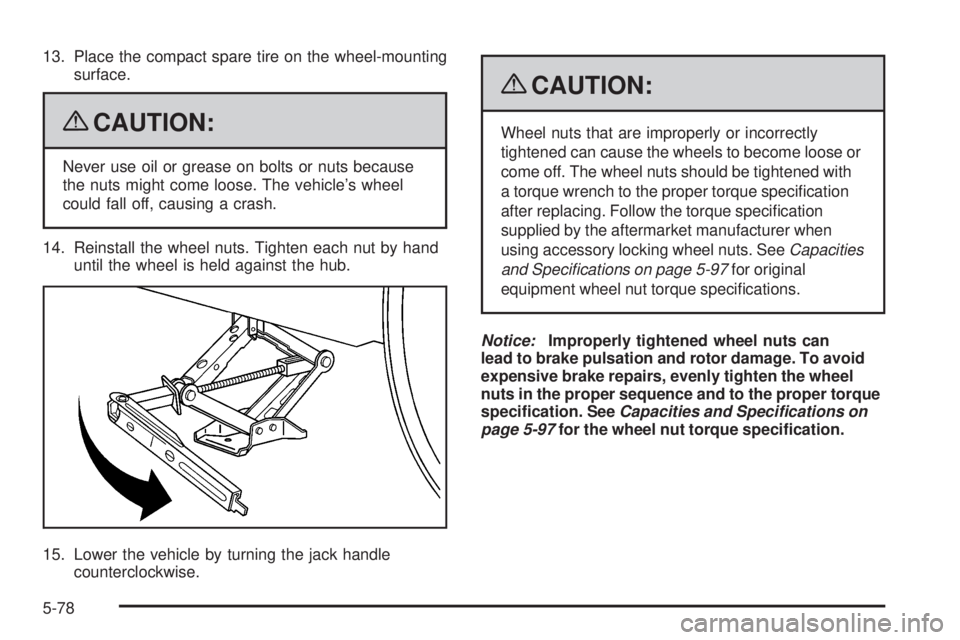Page 300 of 436
When to Add Engine Oil
If the oil is below the cross-hatched area at the
tip of the dipstick, add at least one quart/liter of the
recommended oil. This section explains what kind
of oil to use. For engine oil crankcase capacity,
seeCapacities and Specifications on page 5-97.
Notice:Do not add too much oil. If the engine
has so much oil that the oil level gets above the
cross-hatched area that shows the proper operating
range, the engine could be damaged.SeeEngine Compartment
Overview on page 5-12
for the location of the
engine oil �ll cap.
Add enough oil to put the level somewhere in the proper
operating range in the cross-hatched area. Push the
dipstick all the way back in when through.SAE 5W-30 may not
appear on all caps.
5-16
Page 362 of 436

13. Place the compact spare tire on the wheel-mounting
surface.
{CAUTION:
Never use oil or grease on bolts or nuts because
the nuts might come loose. The vehicle’s wheel
could fall off, causing a crash.
14. Reinstall the wheel nuts. Tighten each nut by hand
until the wheel is held against the hub.
15. Lower the vehicle by turning the jack handle
counterclockwise.
{CAUTION:
Wheel nuts that are improperly or incorrectly
tightened can cause the wheels to become loose or
come off. The wheel nuts should be tightened with
a torque wrench to the proper torque speci�cation
after replacing. Follow the torque speci�cation
supplied by the aftermarket manufacturer when
using accessory locking wheel nuts. SeeCapacities
and Specifications on page 5-97for original
equipment wheel nut torque speci�cations.
Notice:Improperly tightened wheel nuts can
lead to brake pulsation and rotor damage. To avoid
expensive brake repairs, evenly tighten the wheel
nuts in the proper sequence and to the proper torque
speci�cation. SeeCapacities and Specifications on
page 5-97for the wheel nut torque speci�cation.
5-78
Page 381 of 436
Capacities and Speci�cations
The following approximate capacities are given in English and metric conversions. SeeRecommended Fluids and
Lubricants on page 6-13for more information.
ApplicationCapacities
English Metric
Air Conditioning Refrigerant R134aFor the air conditioning system refrigerant charge
amount, see the refrigerant caution label located
under the hood. See your dealer for more
information.
Cooling System
3.4L V6 Engine 10.5 qt 9.9 L
3.6L V6 Engine 11.0 qt 10.4 L
Engine Oil with Filter
3.4L V6 Engine 4.5 qt 4.3 L
3.6L V6 Engine 5.5 qt 5.2 L
5-97